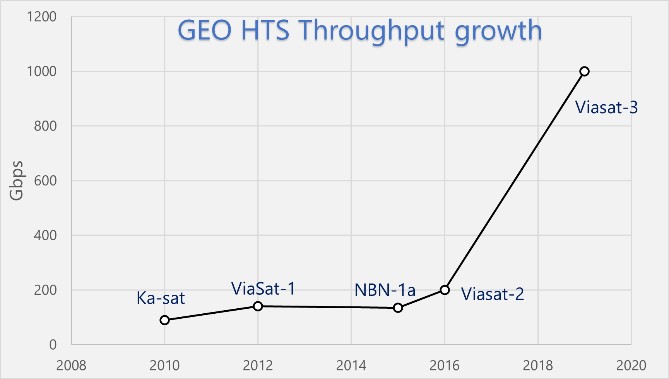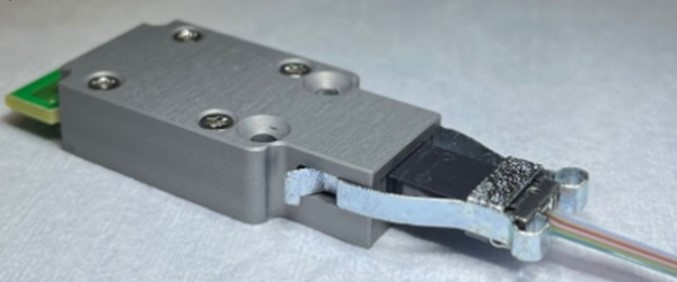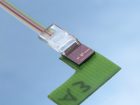Developing optoelectronic modules and subsystems for new generation VHTS (Very High Throughput Satellite) is one of the targets of the European Commission within the Horizon 2020 (H2020) program. Alter Technology actively participates in this development by manufacturing and testing a high-speed optical transceiver integrated chipset and module for onboard VCSEL (Vertical Cavity Surface Emitting Laser) based satellite optical interconnects.
Being connected anywhere at any time is necessary and even a human right in some countries. One of the objectives of developed countries is to achieve connectivity throughout their territory and thus close the digital gap that exists, for example, in rural or difficult-to-access environments where the infrastructure of traditional communications services would be costly and complex. In addition, another important objective is to help developing countries obtain internet connectivity, one of the keys to increasing development. These milestones have led communications operators and government institutions to investigate the development of communications satellites that meet the requirements of high data transfer consumption with very high transmission speed and coverage over larger areas.
Today, new generation communications satellites are called HTS (High Throughput Satellite), which provide much higher throughput for the same amount of orbital spectrum, significantly lowering the cost per bit. These satellites can reach transmission speeds greater than 100Gbit/s, which is 100 times faster than conventional FSS satellites.
Therefore, communication satellite designers have the complexity of getting systems that meet these requirements. So…

How can satellite onboard processors (OBPs) handle such large data?
The high throughput requirement results in a satellite payload that consume a lot of power. It is estimated that 90% of the total power consumption per chip is used for off-chip communication. These factors cause signal distortions in high-speed electrical data communication. For this reason, the European Space Agency commissioned different institutions, such as SPIE (The International Society for Optical Engineering), to carry out a bibliographic study on optical communications between photonic chips and printed circuit boards (PCBs) for next-generation onboard processors. Research on optical interconnects has shown that it is immune to electromagnetic interference, and over distances of up to meters, the optical medium has no bandwidth limits.


Such is the importance of photonic technology that the European Commission has supported the SIPhoDiAS (Photonic-Enabled VHTS) project with funds for research and development. This project aims to develop space-grade optoelectronic modules and subsystems for high-performance VHTS satellites. The optoelectronic interfaces developed by the project are, for example, optical transceivers, analog photodetectors, and modulators that are implemented in the highest volumes and used to interconnect equipment at the edge and within the satellite payload.
Alter Technology is one of the project team members and offers all its experience in Optoelectronics & Photonics technology.
Manufactured and testing of a mid-board optical transceiver chipset
Recently, Alter Technology, within the framework of the SIPhoDiAs project, has presented the manufactured and testing of a mid-board optical transceiver chipset and module applicable to VCSEL (Vertical Cavity Surface Emitting Laser) based intra-satellite optical interconnects. The chipset comprises a four-channel VCSEL driver and a trans-impedance amplifier (TIA), fabricated in IHP’s 130nm rad-hard flavor SiGe BiCMOS (SG13RH) process. Preliminary testing by Alter Technology Labs has validated the functional integrity of the device with a data rate of up to 15 Gb/s per fiber.

An optical transceiver is currently being used in communications satellites. On September 8, 2022, the first commercial satellite using optical interconnects was launched, called Eutelsat KONNECT VHTS, which hosts Thales Alenia Space DTP5G OBP, a processor with digital optical links operating at 10 Gb/s data lanes for board-to-board interconnections. This satellite aims to provide high-speed mobile and broadband connectivity throughout Europe, North Africa, and the Middle East. It has a height of 9 meters, its wingspan exceeds 45 meters, its mass is 6.4 tons at takeoff, and it has a capacity of 500Gbps in the Ka-band. It is currently the largest and most powerful geostationary communications satellite manufactured in Europe.
References:
Optical interconnects for satellite payloads: sizing up state of the art. Article in Proceedings of SPIE (The International Society for Optical Engineering)
- Quantum Key Distribution, Secure Line Communications - 10th November 2022
- Space-Based Quantum Communication - 10th November 2022
- Optical Transceiver In New Generation Satellite Communication - 9th November 2022




